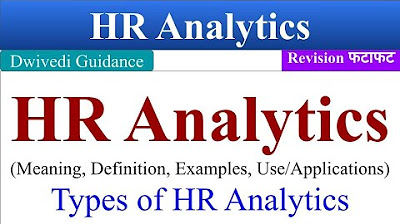The Fundamentals of Predictive Analytics - Data Science Wednesday
Summary
TLDRIn this video, Tessa Jones, a data scientist at Decisive Data, explains the concept of predictive analytics, its role in business decision-making, and how it builds on descriptive and diagnostic analytics. Using the example of a grocery store, she demonstrates how predictive models forecast product sales and assist with inventory and profit management. Tessa also highlights the iterative process of refining predictive models by comparing predicted sales with actual sales to improve accuracy. She concludes by previewing the next topic: prescriptive analytics, which focuses on actions based on future predictions.
Takeaways
- 😀 Predictive analytics helps businesses forecast future outcomes, giving them an edge in decision-making.
- 😀 Descriptive analytics involves summarizing, cleaning, and visualizing data to answer questions about 'what happened'.
- 😀 Diagnostic analytics seeks to understand 'why' something happened by analyzing data relationships and causes.
- 😀 Predictive analytics builds on descriptive and diagnostic analytics, offering a glimpse into potential future events.
- 😀 Businesses can make better decisions by using predictive models to forecast trends, such as product sales.
- 😀 The accuracy of predictive models is based on historical data, which helps form a basis for future predictions.
- 😀 A predictive model incorporates data, mathematics, and coding to generate forecasts, which are then visualized for easy interpretation.
- 😀 It’s essential to track the performance of predictive models to assess their accuracy over time.
- 😀 When a model's predictions are inaccurate, businesses need to reassess assumptions, improve the model, and redeploy it.
- 😀 Predictive analytics can help businesses optimize inventory management, supply chain decisions, and profit margins by predicting future sales.
- 😀 Iterative improvements of predictive models are necessary for achieving the most reliable results, and they depend on the quality of data and objectives.
Q & A
What is the focus of this video?
-The focus of the video is on predictive analytics, explaining its role in business decision-making and how it fits into the broader spectrum of analytics.
What are the different types of analytics discussed in the video?
-The video discusses three types of analytics: descriptive analytics, diagnostic analytics, and predictive analytics.
What does descriptive analytics involve?
-Descriptive analytics involves cleaning, relating, summarizing, and visualizing data to understand what is currently happening in a business.
How does diagnostic analytics differ from descriptive analytics?
-Diagnostic analytics goes deeper by explaining why things are happening in the business, such as understanding the reasons behind revenue fluctuations.
Why is predictive analytics important for businesses?
-Predictive analytics helps businesses make informed decisions by forecasting future events, enabling them to better manage supply chain, inventory, and profit expectations.
What example is used in the video to explain predictive analytics?
-The example used is a grocery store trying to predict how many units of a given product will be sold, helping with inventory management and sales predictions.
What is required before predictive analytics can be applied?
-Before applying predictive analytics, businesses need to understand their past data, as predictions are based on historical trends and patterns.
What kind of model is built in the example, and what does it predict?
-In the example, a predictive model is built using historical sales data to forecast future sales for a specific product in a store.
How is the model's performance evaluated?
-The model's performance is evaluated by comparing actual sales (black line) with predicted sales (green line), and identifying any discrepancies or errors in the prediction.
What happens if the model's predictions are inaccurate?
-If the predictions are inaccurate, the model is revisited, and assumptions are reviewed or adjusted to improve the predictions before redeploying the model.
Outlines

Этот раздел доступен только подписчикам платных тарифов. Пожалуйста, перейдите на платный тариф для доступа.
Перейти на платный тарифMindmap

Этот раздел доступен только подписчикам платных тарифов. Пожалуйста, перейдите на платный тариф для доступа.
Перейти на платный тарифKeywords

Этот раздел доступен только подписчикам платных тарифов. Пожалуйста, перейдите на платный тариф для доступа.
Перейти на платный тарифHighlights

Этот раздел доступен только подписчикам платных тарифов. Пожалуйста, перейдите на платный тариф для доступа.
Перейти на платный тарифTranscripts

Этот раздел доступен только подписчикам платных тарифов. Пожалуйста, перейдите на платный тариф для доступа.
Перейти на платный тарифПосмотреть больше похожих видео

What is Descriptive Analytics? - Data Science Wednesday

Types of Business Analytics (Descriptive, Predictive, and Prescriptive)

Types of Data Analytics

What Is Business Analytics? | Business: Explained

HR Analytics, hr analytics meaning, hr analytics notes, hr analytics example, types of hr analytic

AI Explained: Demystifying AI for Renewable Energy
5.0 / 5 (0 votes)
